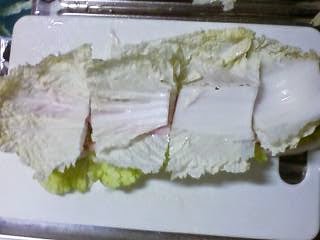In Japan in winter, the quintessential Japanese meal is nabe. Nabe is a hot pot dish traditionally cooked in an earthenware pot. It is often done at parties and cooked on a gas burner at the table. Various vegetable and meat ingredients are cooked in a broth. Guests take what they like and eat and more ingredients are added. There are infinite variations and recipes. Nothing warms a body better on a cold winter's day that a steaming bowl of nabe. This is a really simple and delicious recipe using Chinese cabbage and pork. Serves 1-2 people.
Ingredients:
- 5-6 large leaves Chinese cabbage
- 300 grams thinly sliced pork
- 1 half large onion
- 1 cup of water
- 5 grams or so of granulated fish stock-hondashi
- 1 Tblsp. salt
- 6 Tblsp. soy sauce
- 1 Tblsp. mirin(cooking sake)
Directions:
1. Wash and cut the Chinese cabbage leaves in half lengthwise.

2. Stack alternating layers of Chinese cabbage and sliced pork. Change the direction of the cabbage leaves each time. Stack until about 5 leaves thick.
3. Cut the stack into 5 cm/ about 2 inch lengths.
4. Fill the nabe pot with the cut leaves standing up. Repeat with all the leaves and pork. Make a spiral pattern in the pot until no more fits.
5. Cut half an onion into small pieces and stick into any empty spaces.
6. Add the water, fish stock, and salt, cover and bring to a boil.
7. Once boils, reduce heat and add soy sauce generously. Replace lid and simmer until cooked.
The pork and Chinese cabbage cooked in the broth makes a great combination. So tasty and hot!



















